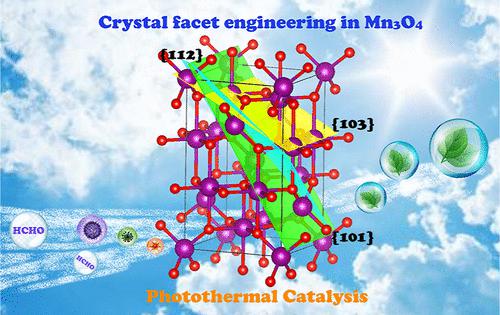当前位置:
X-MOL 学术
›
ACS Catal.
›
论文详情
Our official English website, www.x-mol.net, welcomes your
feedback! (Note: you will need to create a separate account there.)
Facet-Controlled Synthesis of Mn3O4 Nanorods for Photothermal Synergistic Catalytic Oxidation of Carcinogenic Airborne Formaldehyde
ACS Catalysis ( IF 11.3 ) Pub Date : 2023-05-31 , DOI: 10.1021/acscatal.3c01099 Taohong He 1, 2 , Shaopeng Rong 1 , Danni Ding 1 , Yu Zhou 1 , Nan Zhang 1 , Weijiang He 1
ACS Catalysis ( IF 11.3 ) Pub Date : 2023-05-31 , DOI: 10.1021/acscatal.3c01099 Taohong He 1, 2 , Shaopeng Rong 1 , Danni Ding 1 , Yu Zhou 1 , Nan Zhang 1 , Weijiang He 1
Affiliation

|
Crystal facet engineering, the selective exposure of reactive crystal facets, has emerged as an important technique for the design of efficient catalysts. However, in the facet-controlled synthesis of nanocrystals by either traditional top-down or bottom-up routes, the selection of capping agents is crucial and challenging. Herein, a phase transition strategy that does not require the assistance of capping/etching agents was developed to achieve the selective exposure of {103}, {101}, and {112} facets in Mn3O4. Facet-dependent activity in the photothermal decomposition of the carcinogen formaldehyde was investigated. The resulting Mn3O4 with exposed {103} facets showed the best photothermal catalytic activity, achieving the complete mineralization of formaldehyde at ambient temperature. The synergistic mechanism of the photothermal catalysis of Mn3O4 was discovered to be a thermal-assisted photocatalytic process rather than solar-light-driven thermal catalysis. In addition, the photothermal synergistic decomposition process of HCHO was also revealed. The photothermal decomposition of HCHO undergoes the processes of HCHO → DOM (dioxymethylene) → formates → carbonates → CO2. The findings proposed in this work not only broaden the study of crystal facet engineering but also provide suggestions for the purification of volatile organic compounds (VOCs) in indoor air.
中文翻译:

晶面控制合成 Mn3O4 纳米棒用于光热协同催化氧化空气中致癌甲醛
晶面工程,反应性晶面的选择性暴露,已成为设计高效催化剂的重要技术。然而,在通过传统的自上而下或自下而上路线进行的纳米晶面控制合成中,封端剂的选择至关重要且具有挑战性。在此,开发了一种不需要封端/蚀刻剂辅助的相变策略,以实现 Mn 3 O 4中 {103}、{101} 和 {112} 晶面的选择性暴露。研究了致癌物甲醛光热分解中的小平面依赖性活性。生成的 Mn 3 O 4暴露的{103}面表现出最好的光热催化活性,在环境温度下实现了甲醛的完全矿化。Mn 3 O 4光热催化的协同机制被发现是一种热辅助光催化过程,而不是太阳光驱动的热催化。此外,还揭示了 HCHO 的光热协同分解过程。HCHO的光热分解经历了HCHO→DOM(二甲醛)→甲酸盐→碳酸盐→CO 2的过程。这项工作中提出的发现不仅拓宽了晶面工程的研究,而且为净化室内空气中的挥发性有机化合物 (VOC) 提供了建议。
更新日期:2023-05-31
中文翻译:

晶面控制合成 Mn3O4 纳米棒用于光热协同催化氧化空气中致癌甲醛
晶面工程,反应性晶面的选择性暴露,已成为设计高效催化剂的重要技术。然而,在通过传统的自上而下或自下而上路线进行的纳米晶面控制合成中,封端剂的选择至关重要且具有挑战性。在此,开发了一种不需要封端/蚀刻剂辅助的相变策略,以实现 Mn 3 O 4中 {103}、{101} 和 {112} 晶面的选择性暴露。研究了致癌物甲醛光热分解中的小平面依赖性活性。生成的 Mn 3 O 4暴露的{103}面表现出最好的光热催化活性,在环境温度下实现了甲醛的完全矿化。Mn 3 O 4光热催化的协同机制被发现是一种热辅助光催化过程,而不是太阳光驱动的热催化。此外,还揭示了 HCHO 的光热协同分解过程。HCHO的光热分解经历了HCHO→DOM(二甲醛)→甲酸盐→碳酸盐→CO 2的过程。这项工作中提出的发现不仅拓宽了晶面工程的研究,而且为净化室内空气中的挥发性有机化合物 (VOC) 提供了建议。











































 京公网安备 11010802027423号
京公网安备 11010802027423号